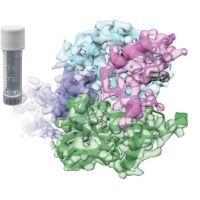Specification
| Organism | Homo sapiens (Human) |
| Expression Host | E.coli |
| Tag Info | N-terminal 6xHis-SUMO-tagged |
| Purity | Greater than 85% by SDS-PAGE |
| Uniprot ID | Q92743 |
| Gene Names | HTRA1 |
| Alternative Names | High-temperature requirement A serine peptidase 1 L56 Serine protease 11 |
| Expression Region | Full Length of Mature Protein(23-480aa ) |
| Molecular Weight | 65 kDa |
| Protein Sequence | QLSRAGRSAPLAAGCPDRCEPARCPPQPEHCEGGRARDACGCCEVCGAPEGAACGLQEGPCGEGLQCVVPFGVPASATVRRRAQAGLCVCASSEPVCGSDANTYANLCQLRAASRRSERLHRPPVIVLQRGACGQGQEDPNSLRHKYNFIADVVEKIAPAVVHIELFRKLPFSKREVPVASGSGFIVSEDGLIVTNAHVVTNKHRVKVELKNGATYEAKIKDVDEKADIALIKIDHQGKLPVLLLGRSSELRPGEFVVAIGSPFSLQNTVTTGIVSTTQRGGKELGLRNSDMDYIQTDAIINYGNSGGPLVNLDGEVIGINTLKVTAGISFAIPSDKIKKFLTESHDRQAKGKAITKKKYIGIRMMSLTSSKAKELKDRHRDFPDVISGAYIIEVIPDTPAEAGGLKENDVIISINGQSVVSANDVSDVIKRESTLNMVVRRGNEDIMITVIPEEIDP |
| Form | Liquid or Lyophilization |
| Buffer | The default storage buffer is Tris/PBS-based buffer, 5%-50% glycerol if the delivery form is liquid. The lyophilization buffer is Tris/PBS-based buffer, 6% Trehalose, pH 8.0 if the delivery form is lyophilized powder. Please contact us if you have any special requirment. |
| Reconstitution | Please reconstitute protein in deionized sterile water and we recommend that briefly centrifuge thevial prior to opening the vial .We recommend aliquot for long-term storage at -20℃/-80℃. |
Background
| Relevance | Serine protease with a variety of targets, including Extracellular domain matrix proteins such as fibronectin. HTRA1-generated fibronectin fragments further induce synovial cells to up-regulate MMP1 and MMP3 production. May also degrade proteoglycans, such as aggrecan, decorin and fibromodulin. Through cleavage of proteoglycans, may release soluble FGF-glycosaminoglycan complexes that promote the range and intensity of FGF signals in the Extracellular domain space. Regulates the availability of insulin-like growth factors (IGFs) by cleaving IGF-binding proteins. Inhibits signaling mediated by TGF-beta family members. This activity requires the integrity of the catalytic site, although it is unclear whether TGF-beta proteins are themselves degraded. By acting on TGF-beta signaling, may regulate many physiological processes, including retinal angiogenesis and neuronal survival and maturation during development. Intracellularly, degrades TSC2, leading to the activation of TSC2 downstream targets. |
| Involvement in Disease | Macular degeneration, age-related, 7 (ARMD7); Cerebral arteriopathy, autosomal recessive, with subcortical infarcts and leukoencephalopathy (CARASIL); Cerebral arteriopathy, autosomal dominant, with subcortical infarcts and leukoencephalopathy, 2 (CADASIL2) |
| Subcellular Location | Cell membrane, Secreted, Cytoplasm, cytosol |
| Protein Families | Peptidase S1C family |
| Tissue Specificity | HTRA1 |
QC Data
| Note | Please contact us for QC Data |
| Product Image (Reference Only) |  |

